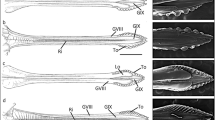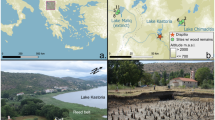Abstract
Ophelia cluthensis was described in 1935 by McGuire1, who obtained her specimens from Millport in the Clyde, and more fully in 1938 by Brown2. It occurs in a narrow zone of sandy beaches just below high-water mark neaps, frequently to the extent of several hundred to the square metre. Besides being recorded from the Firths of Clyde and Forth, Wohlen-berg3 records its presence at Sylt, Germany. Specimens obtained by Fauvel4 at Saint-Vaast, France, were described by him as young O. limacina but are considered by Brown to be probably O. cluthensis.
This is a preview of subscription content, access via your institution
Access options
Subscribe to this journal
Receive 51 print issues and online access
$199.00 per year
only $3.90 per issue
Buy this article
- Purchase on Springer Link
- Instant access to full article PDF
Prices may be subject to local taxes which are calculated during checkout
Similar content being viewed by others
References
McGuire, Scot. Naturalist, 45 (1935).
Brown, Proc. Roy. Soc. Edin., 58 (2), 135 (1938).
Wohlenberg, Helgol. Wise. Meeresuntersuch., 1 (1), 1–92 (1937).
Fauvel, Bull. Soc. Zool. Fran., 1, 77–88 (1925).
Author information
Authors and Affiliations
Rights and permissions
About this article
Cite this article
REES, C. Distribution of the Polychæte Ophelia cluthensis McGuire. Nature 142, 576–577 (1938). https://doi.org/10.1038/142576b0
Issue Date:
DOI: https://doi.org/10.1038/142576b0
Comments
By submitting a comment you agree to abide by our Terms and Community Guidelines. If you find something abusive or that does not comply with our terms or guidelines please flag it as inappropriate.



